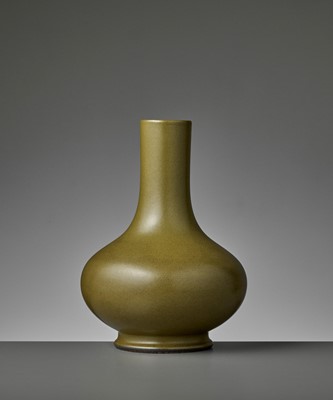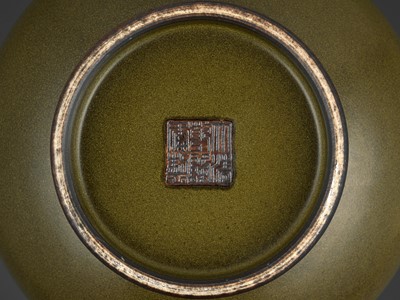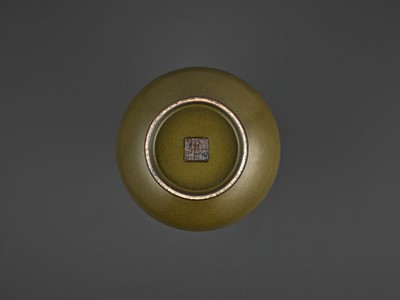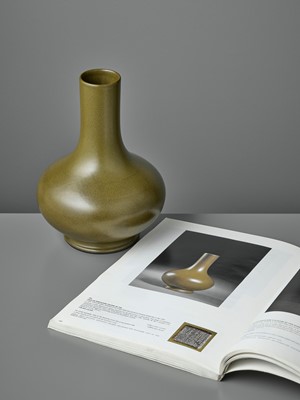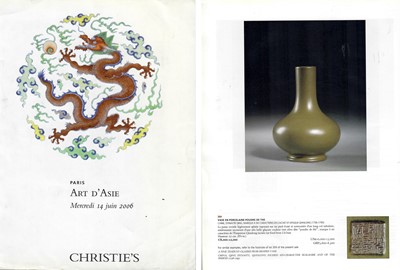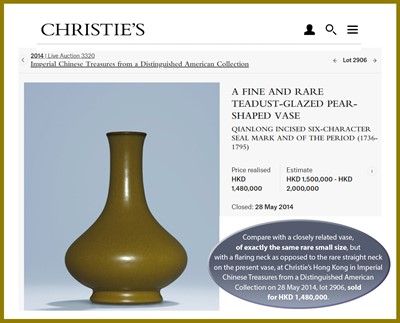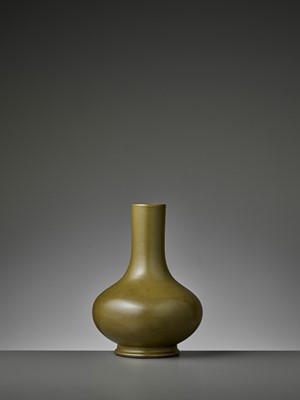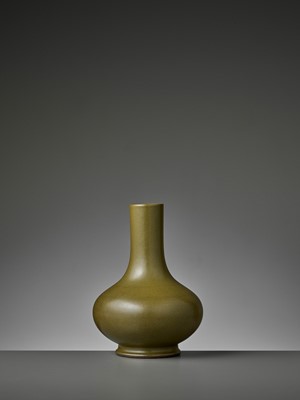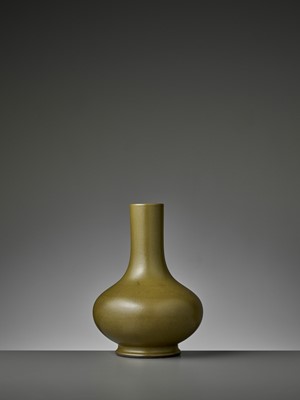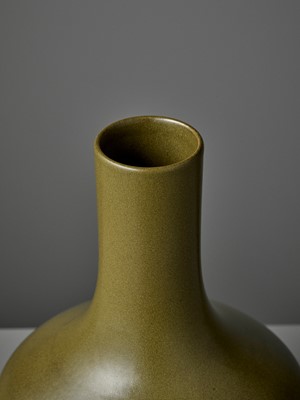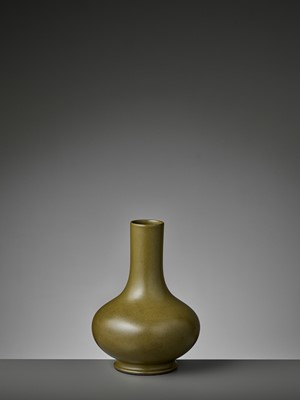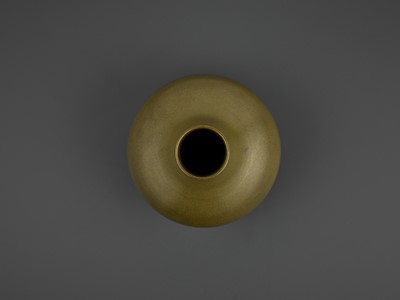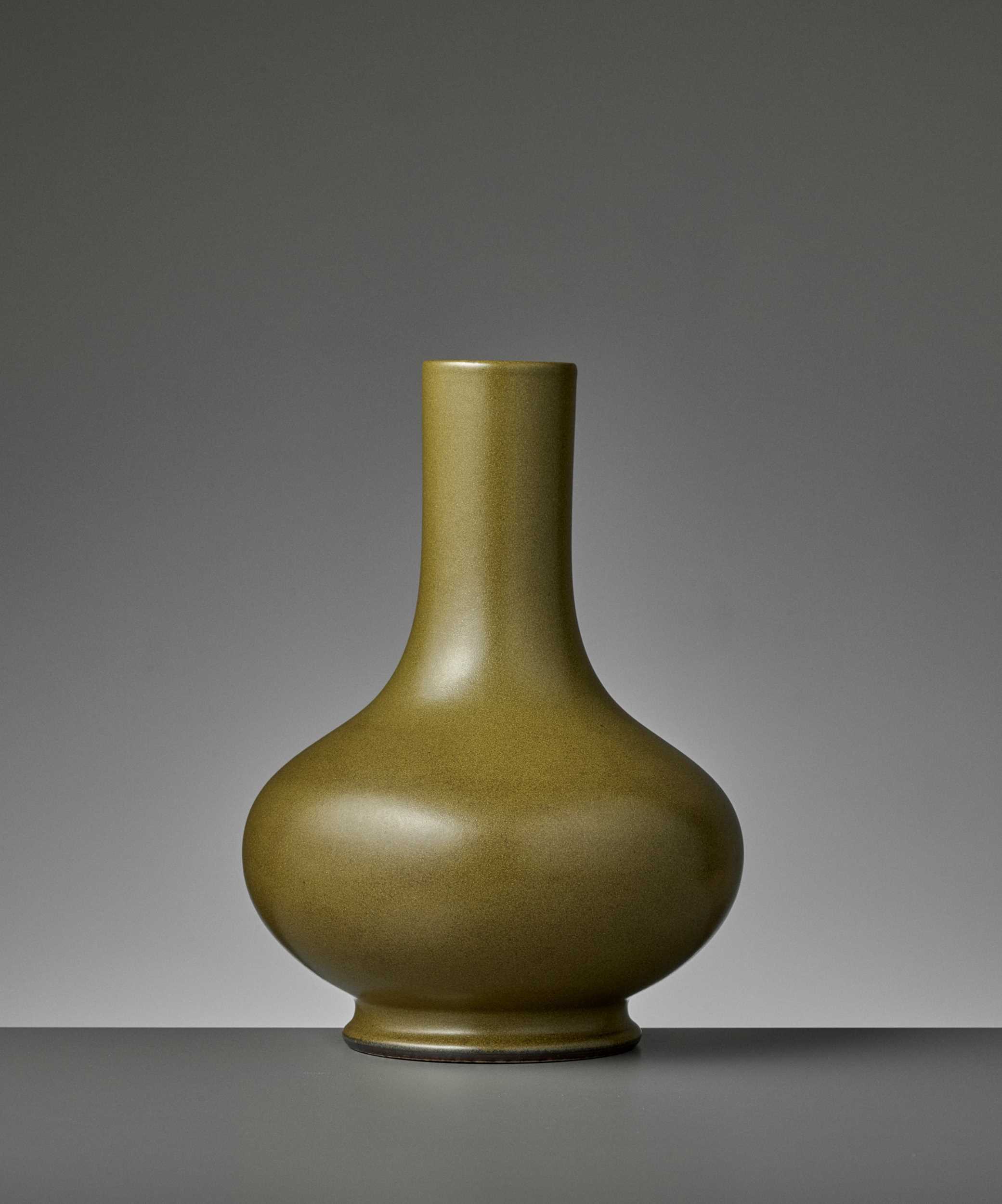15th Oct, 2021 10:00
TWO-DAY AUCTION - Fine Chinese Art / 中國藝術集珍 / Buddhism & Hinduism
231
A TEADUST-GLAZED BOTTLE VASE, QIANLONG MARK AND PERIOD
乾隆款與年代茶葉末釉荸薺瓶
Sold for €50,560
including Buyer's Premium
China, 1735-1796. The compressed globular body rising from a slightly waisted foot with a molded edge to a superbly potted cylindrical neck. Covered overall with a finely mottled, elegant silky matte glaze of deep olive-green color that also covers the base. The foot is covered by a dark brown wash. Neatly incised six-character da Qing Qianlong nianzhi seal mark and of the period, the mark itself highlighted by a russet-brown glaze.
Provenance: Christie's Paris, 14 June 2006, lot 364. Austrian private collection.
Condition: Absolutely perfect condition with only very minor wear and firing irregularities.
Weight: 906.0 g
Dimensions: Height 21.5 cm
Fine tea-dust glazed porcelains are particularly associated with the Qing dynasty reigns of the Yongzheng and Qianlong Emperors, and it is of interest to note that, like those vessels with a robin’s-egg glaze, tea-dust porcelains usually bear seal-script marks in both the Yongzheng and Qianlong reigns.
The fine tea-dust glazes of the 18th century are linked to the most famous and revered of all the supervisors of the imperial kilns, Tang Ying (1682-1756). Tang Ying’s document ‘Commemorative Stele on Ceramic Production’ from 1735 provides information on 57 types of porcelain ware, including 40 monochrome glazes. Amongst these, there is reference to ‘copy workshop glaze’ fang changguan, i.e. tea-dust, and a listing of three variants: eel-skin yellow, snake-skin green, and speckled yellow. It is interesting that these are called fang or copies, since it suggests that the kilns were specifically copying an ancient glaze, most probably a Tang or Song dynasty original tea-dust glaze from northern China.
Expert’s note: Although Qianlong-marked teadust-glazed vases of this general form are well known, smaller examples are very rare, and the current vase further distinguishes itself with its unusually fine and even glaze as well as its magnificent quality of pottery.
Literature comparison: A teadust-glazed vase of similar small size and proportions is illustrated by J Ayers in Chinese Ceramics and the Baur Collection, Geneva, 1999, no. 297. Another is illustrated by R. Krahl in Chinese Ceramics from the Meiyintang Collection, London, 1994, vol. 2, no. 917. A related Qianlong-marked vase of this form, but of the more common larger size, from the T.Y. Chao Collection, was sold at Sotheby's Hong Kong, 19 May 1987, lot 294; and another in the Victoria and Albert Museum, London, illustrated by R. Kerr in Chinese Ceramics, Porcelain of the Qing Dynasty, 1644-1911, London, 1986, no. 25.
Auction result comparison: Compare with a closely related vase, of exactly the same rare small size, but with a flaring neck as opposed to the rare straight neck on the present vase, at Christie’s Hong Kong in Imperial Chinese Treasures from a Distinguished American Collection on 28 May 2014, lot 2906, sold for HKD 1,480,000.
乾隆款與年代茶葉末釉荸薺瓶
中國,1735-1796年。直頸長頎、溜肩、扁鼓腹,底承圈足,底部正中落“大清乾隆年製”六字篆書款。器形飽滿端正,重心下移,愈顯豐腴大方。整器通體施茶葉末釉,釉質潤澤,釉色勻凈而深沉。
來源:巴黎佳士得,2006年6月14日,lot 364。奧地利私人收藏
品相:對完美的狀態,只有極少的磨損和燒傷不規則現象。
重量:906.0 克
尺寸:高21.5厘米
器瓶為清宮瓷器燒造的傳統形制之一,始於康熙朝,而尤盛於乾隆。因器形似荸薺而得名。此瓶造型端莊規整,釉質釉色靜穆,盡顯大氣雅緻。清代茶葉末釉製品多為景德鎮官窯所燒,傳世品中,以雍正和乾隆時期最多見,並以乾隆時的燒製最為成功。
拍賣結果比較:一件相近的茶葉末釉瓶,幾乎一樣的小尺寸,但頸部不同,售于香港佳士得Imperial Chinese Treasures from a Distinguished American Collection拍場,2014年5月28 日,售價HKD 1,480,000。
China, 1735-1796. The compressed globular body rising from a slightly waisted foot with a molded edge to a superbly potted cylindrical neck. Covered overall with a finely mottled, elegant silky matte glaze of deep olive-green color that also covers the base. The foot is covered by a dark brown wash. Neatly incised six-character da Qing Qianlong nianzhi seal mark and of the period, the mark itself highlighted by a russet-brown glaze.
Provenance: Christie's Paris, 14 June 2006, lot 364. Austrian private collection.
Condition: Absolutely perfect condition with only very minor wear and firing irregularities.
Weight: 906.0 g
Dimensions: Height 21.5 cm
Fine tea-dust glazed porcelains are particularly associated with the Qing dynasty reigns of the Yongzheng and Qianlong Emperors, and it is of interest to note that, like those vessels with a robin’s-egg glaze, tea-dust porcelains usually bear seal-script marks in both the Yongzheng and Qianlong reigns.
The fine tea-dust glazes of the 18th century are linked to the most famous and revered of all the supervisors of the imperial kilns, Tang Ying (1682-1756). Tang Ying’s document ‘Commemorative Stele on Ceramic Production’ from 1735 provides information on 57 types of porcelain ware, including 40 monochrome glazes. Amongst these, there is reference to ‘copy workshop glaze’ fang changguan, i.e. tea-dust, and a listing of three variants: eel-skin yellow, snake-skin green, and speckled yellow. It is interesting that these are called fang or copies, since it suggests that the kilns were specifically copying an ancient glaze, most probably a Tang or Song dynasty original tea-dust glaze from northern China.
Expert’s note: Although Qianlong-marked teadust-glazed vases of this general form are well known, smaller examples are very rare, and the current vase further distinguishes itself with its unusually fine and even glaze as well as its magnificent quality of pottery.
Literature comparison: A teadust-glazed vase of similar small size and proportions is illustrated by J Ayers in Chinese Ceramics and the Baur Collection, Geneva, 1999, no. 297. Another is illustrated by R. Krahl in Chinese Ceramics from the Meiyintang Collection, London, 1994, vol. 2, no. 917. A related Qianlong-marked vase of this form, but of the more common larger size, from the T.Y. Chao Collection, was sold at Sotheby's Hong Kong, 19 May 1987, lot 294; and another in the Victoria and Albert Museum, London, illustrated by R. Kerr in Chinese Ceramics, Porcelain of the Qing Dynasty, 1644-1911, London, 1986, no. 25.
Auction result comparison: Compare with a closely related vase, of exactly the same rare small size, but with a flaring neck as opposed to the rare straight neck on the present vase, at Christie’s Hong Kong in Imperial Chinese Treasures from a Distinguished American Collection on 28 May 2014, lot 2906, sold for HKD 1,480,000.
乾隆款與年代茶葉末釉荸薺瓶
中國,1735-1796年。直頸長頎、溜肩、扁鼓腹,底承圈足,底部正中落“大清乾隆年製”六字篆書款。器形飽滿端正,重心下移,愈顯豐腴大方。整器通體施茶葉末釉,釉質潤澤,釉色勻凈而深沉。
來源:巴黎佳士得,2006年6月14日,lot 364。奧地利私人收藏
品相:對完美的狀態,只有極少的磨損和燒傷不規則現象。
重量:906.0 克
尺寸:高21.5厘米
器瓶為清宮瓷器燒造的傳統形制之一,始於康熙朝,而尤盛於乾隆。因器形似荸薺而得名。此瓶造型端莊規整,釉質釉色靜穆,盡顯大氣雅緻。清代茶葉末釉製品多為景德鎮官窯所燒,傳世品中,以雍正和乾隆時期最多見,並以乾隆時的燒製最為成功。
拍賣結果比較:一件相近的茶葉末釉瓶,幾乎一樣的小尺寸,但頸部不同,售于香港佳士得Imperial Chinese Treasures from a Distinguished American Collection拍場,2014年5月28 日,售價HKD 1,480,000。
Zacke Live Online Bidding
Our online bidding platform makes it easier than ever to bid in our auctions! When you bid through our website, you can take advantage of our premium buyer's terms without incurring any additional online bidding surcharges.
To bid live online, you'll need to create an online account. Once your account is created and your identity is verified, you can register to bid in an auction up to 12 hours before the auction begins.
Intended Spend and Bid Limits
When you register to bid in an online auction, you will need to share your intended maximum spending budget for the auction. We will then review your intended spend and set a bid limit for you. Once you have pre-registered for a live online auction, you can see your intended spend and bid limit by going to 'Account Settings' and clicking on 'Live Bidding Registrations'.
Your bid limit will be the maximum amount you can bid during the auction. Your bid limit is for the hammer price and is not affected by the buyer’s premium and VAT. For example, if you have a bid limit of €1,000 and place two winning bids for €300 and €200, then you will only be able to bid €500 for the rest of the auction. If you try to place a bid that is higher than €500, you will not be able to do so.
Online Absentee and Telephone Bids
You can now leave absentee and telephone bids on our website!
Absentee Bidding
Once you've created an account and your identity is verified, you can leave your absentee bid directly on the lot page. We will contact you when your bids have been confirmed.
Telephone Bidding
Once you've created an account and your identity is verified, you can leave telephone bids online. We will contact you when your bids have been confirmed.
Classic Absentee and Telephone Bidding Form
You can still submit absentee and telephone bids by email or fax if you prefer. Simply fill out the Absentee Bidding/Telephone bidding form and return it to us by email at office@zacke.at or by fax at +43 (1) 532 04 52 20. You can download the PDF from our Upcoming Auctions page.
How-To Guides
How to Create Your Personal Zacke Account
How to Register to Bid on Zacke Live
How to Leave Absentee Bids Online
How to Leave Telephone Bids Online
中文版本的操作指南
创建新账号
注册Zacke Live在线直播竞拍(免平台费)
缺席投标和电话投标
Third-Party Bidding
We partner with best-in-class third-party partners to make it easy for you to bid online in the channel of your choice. Please note that if you bid with one of our third-party online partners, then there will be a live bidding surcharge on top of your final purchase price. You can find all of our fees here. Here's a full list of our third-party partners:
- 51 Bid Live
- EpaiLive
- ArtFoxLive
- Invaluable
- LiveAuctioneers
- the-saleroom
- lot-tissimo
- Drouot
Please note that we place different auctions on different platforms. For example, in general, we only place Chinese art auctions on 51 Bid Live.
Bidding in Person
You must register to bid in person and will be assigned a paddle at the auction. Please contact us at office@zacke.at or +43 (1) 532 04 52 for the latest local health and safety guidelines.
